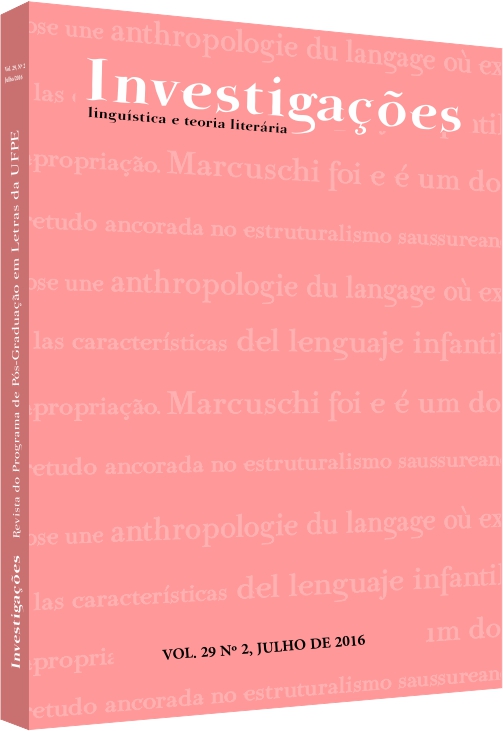La modernité et les études du langage
Abstract
En parlant de "l’art pur", Baudelaire le définit comme la création d’une magie suggestive contenant à la fois l’objet et le sujet, le monde extérieur à l’artiste et l’artiste lui-même. Cette définition nous amène à un changement de la conception du langage au XIXe siècle. Ce changement même se retrouve dans le travail de Benveniste au XXe siècle, notamment dans sa réflexion sur la subjectivité dans le langage et sur la notion de discours. À partir de cette conception du langage, ce travail propose de débattre des questions qui peuvent être posées aux études du langage actuelles.
References
BAUDELAIRE, Charles. Œuvres complètes. Paris: R. Laffont, 1980.
BENVENISTE, Émile. Problèmes de linguistique générale, I. Paris: Gallimard, 1966.
______. Problèmes de linguistique générale, II. Paris: Galimard, 1974.
DESSONS, Gérard. Émile Benveniste, l’invention du discours. Paris: Éditions IN PRESS, 2006.
______. Le Poème. Paris: Armand Colin, 2011.
______. Du discursif. In.: Linguistique et poétique du discours à partir de Saussure, revue Langages, nº 159, sept. 2005.
JAKOBSON, Roman. Linguistique et poétique. In.: ______. Essais de linguistique général. Lonrai: Les Éditions de Minuit, 1963/2003.
MESCHONNIC, Henri. Politique du rythme. France: Éditions Verdier, 1995.
______. Modernité modernité. France: Éditions Verdier, 1988.
______. La Rime et la vie. France: Gallimard, 2006.
______. Benveniste: sémantique sans sémiotique. In.: ______. Dans le bois de la langue. Paris: Éditions Laurence Teper, 2008.
Downloads
Published
How to Cite
Issue
Section
License
Copyright (c) 2016 Daiane Neumann

This work is licensed under a Creative Commons Attribution 4.0 International License.
Authors who publish with Revista Investigações agree to the following terms:
Authors retain copyright and grant the journal right of first publication with the work simultaneously licensed under the Creative Commons Attribution 4.0 International (CC BY 4.0) license that allows others to share the work with an acknowledgement of the work's authorship and initial publication in this journal.
Authors are able to enter into separate, additional contractual arrangements for the non-exclusive distribution of the journal's published version of the work (e.g., post it to an institutional repository or publish it in a book), with an acknowledgement of its initial publication in this journal.
You are free to:
Share — copy and redistribute the material in any medium or format for any purpose, even commercially.
Adapt — remix, transform, and build upon the material for any purpose, even commercially.
The licensor cannot revoke these freedoms as long as you follow the license terms.
Under the following terms:
Attribution — You must give appropriate credit , provide a link to the license, and indicate if changes were made . You may do so in any reasonable manner, but not in any way that suggests the licensor endorses you or your use.
No additional restrictions — You may not apply legal terms or technological measures that legally restrict others from doing anything the license permits.

